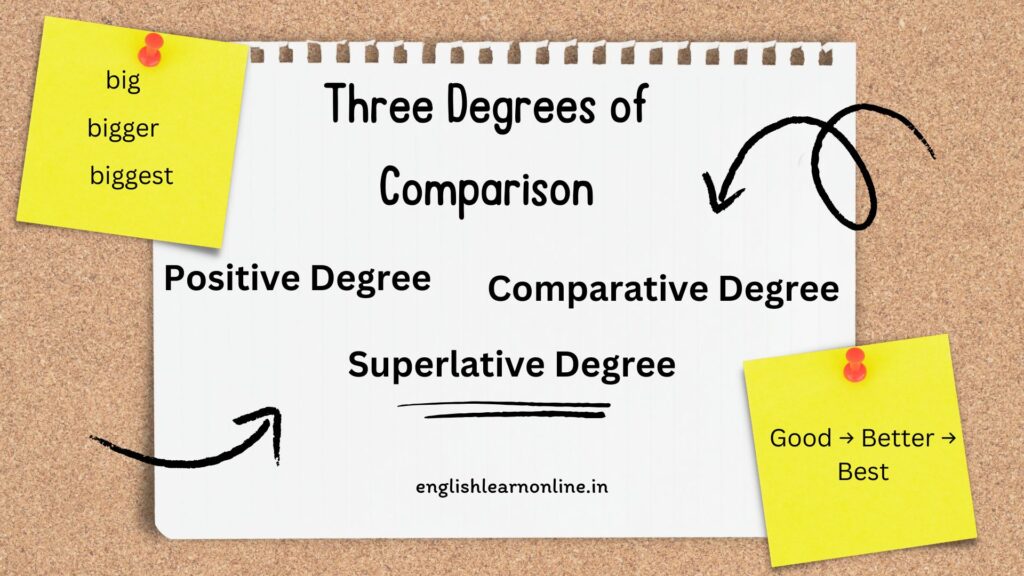Introduction
When we learn English, we often want to describe how things or people are different or similar. This is called making comparisons. For example, we might say, “This book is more interesting than that one” or “He is the tallest student in the class.” Understanding how to compare correctly is a key skill in English grammar.
In this article, you will learn 7 simple but powerful tips to master comparisons in English. We will cover rules, give clear examples, point out common mistakes, and even include a short quiz to help you practice. Let’s begin!
Tip 1: Understand the Three Types of Comparison
English comparisons come in three forms:
- Positive: This is the base form of the adjective or adverb. Example: fast, tall, beautiful
- Comparative: Used to compare two people or things. Example: faster, taller, more beautiful
- Superlative: Used to show the highest or lowest in a group. Example: fastest, tallest, most beautiful
Examples in Sentences:
- Positive: “This road is long.”
- Comparative: “This road is longer than that one.”
- Superlative: “This is the longest road in the city.”
✅ Visual Tip:
- One thing: Positive
- Two things: Comparative (add -er or use ‘more’)
- Three or more: Superlative (add -est or use ‘most’)
Tip 2: Know the Right Structure
Using the right grammar structure is important for clarity.
Comparative Structure:
- Subject + verb + comparative adjective + than + object
- Example: “John is taller than Sam.”
Superlative Structure:
- Subject + verb + the + superlative adjective + object
- Example: “John is the tallest student in the class.”
✅ Quick Reminder:
- Use than with comparatives.
- Use the with superlatives.
Tip 3: Learn Common Irregular Adjectives
Some adjectives don’t follow the usual rules. These are called irregular adjectives.
| Positive | Comparative | Superlative |
|---|---|---|
| Good | Better | Best |
| Bad | Worse | Worst |
| Far | Farther | Farthest |
| Little | Less | Least |
| Many | More | Most |
✅ Remember:
- Never say more better or more worse. These are incorrect.

Tip 4: Be Careful with Spelling Rules
When forming comparatives and superlatives, spelling changes often occur:
- One-syllable adjectives:
- Add -er and -est
- Example: small → smaller → smallest
- One-syllable ending in a single vowel + consonant:
- Double the consonant
- Example: big → bigger → biggest
- Two-syllable adjectives ending in -y:
- Change y to i and add -er or -est
- Example: happy → happier → happiest
- Two or more syllables:
- Use more and most
- Example: beautiful → more beautiful → most beautiful
✅ Spelling Table:
| Adjective | Comparative | Superlative |
|---|---|---|
| Big | Bigger | Biggest |
| Happy | Happier | Happiest |
| Famous | More famous | Most famous |
Tip 5: Avoid Double Comparisons
Common Mistake: Saying both more and -er together.
❌ Incorrect: “She is more prettier than her sister.”
✅ Correct: “She is prettier than her sister.”
Remember: Use only one form — either the -er ending or more, not both.
Tip 6: Don’t Compare Incompatible Things
You should only compare things that are similar or of the same category.
❌ Incorrect: “Her singing is better than her dress.”
✅ Correct: “Her singing is better than his singing.”
When comparing, ask yourself: Am I comparing the same type of thing? If not, rewrite the sentence.
Tip 7: Practice Makes Perfect
The best way to master comparisons is by using them in real-life situations. Try these steps:
- Describe two things you see: “This chair is more comfortable than that one.”
- Talk about people: “My sister is more hardworking than me.”
- Use superlatives in your stories: “It was the best day of my life.”
✅ Daily Practice Ideas:
- Compare foods you eat
- Compare places you visit
- Compare people you know (kindly!)
Common Errors to Watch Out For
- Don’t mix up more and most.
- Don’t use double comparisons.
- Don’t forget “than” in comparative sentences.
- Use “the” with superlatives.
- Don’t compare different types of things.
Practice Quiz: Test Your Knowledge
1. Choose the correct form:
- This car is (fast / faster / fastest) than that one.
✅ Answer: faster
2. Fill in the blank:
- He is the _______ player in the team. (good)
✅ Answer: best
3. Choose the correct sentence:
- a) She is more taller than me.
- b) She is taller than me.
✅ Answer: b
4. Correct the sentence:
- “This movie is more interesting than the actor.”
✅ *Correct version: This movie is more interesting than that one.”
5. Which one is incorrect?
- a) The weather is worse today.
- b) He is more smarter than me.
- c) She is the tallest girl in class. ✅ Answer: b (more smarter is incorrect)
Conclusion
Comparisons help us express differences and similarities clearly in English. By learning the basic rules, common patterns, and avoiding typical errors, you can speak and write more confidently.
Let’s quickly recap the 7 tips:
- Learn the 3 types: positive, comparative, superlative
- Use the correct sentence structure
- Remember irregular adjectives
- Watch your spelling
- Avoid double comparisons
- Compare similar things only
- Practice daily with examples
Practice a little every day, and soon comparisons will become a natural part of your English!
